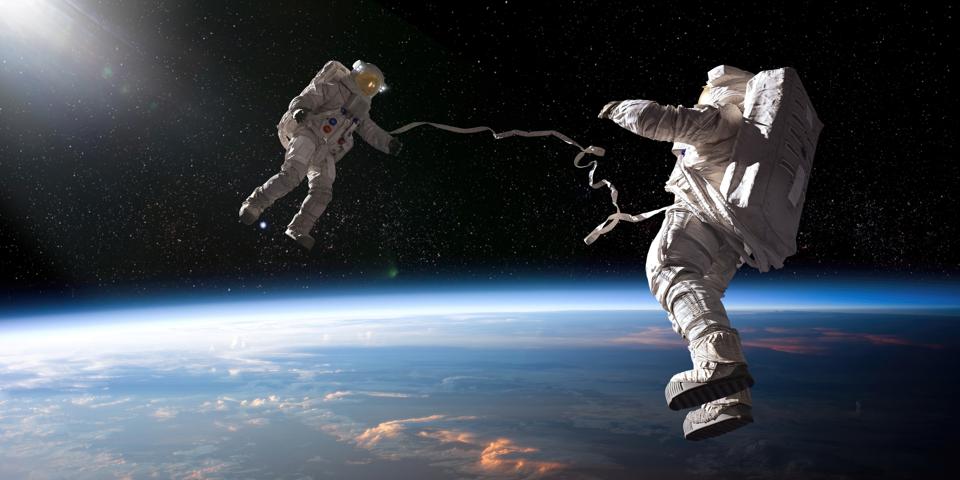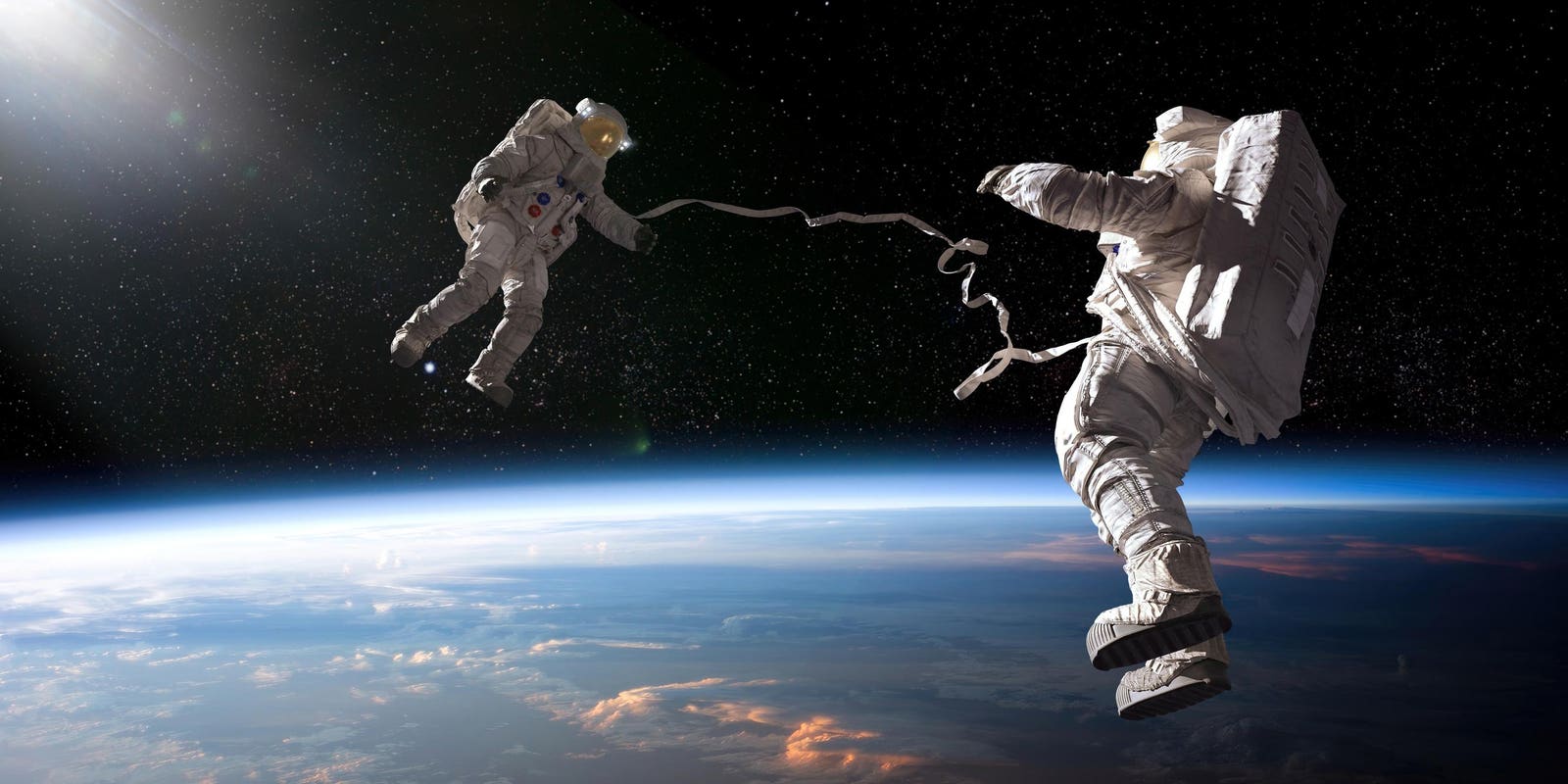
Two astronauts in full spacesuits with backpacks on a space walk with tethers, facing each other with hands out. The astronauts are in front of planet earth and some distant stars are also visible. Earth image from NASA: https://eoimages.gsfc.nasa.gov/images/imagerecords/50000/50205/ISS027-E-012224_lrg.jpg
getty
Among the questions that astrobiology frequently raises, one is whether life here is destined to leave the planet for the sake of its own preservation.
It’s a question that I touched on some 25 years ago in my book “Distant Wanderers: The Search for Planets beyond the Solar System.” But renowned NASA astrobiologist Caleb Scharf examines this issue in detail in his compelling new book, “The Giant Leap: Why Space is the Next Frontier in the Evolution of Life.”
Are our baby steps into space wholly anomalous or do they signal a natural evolution of life on this planet? And if it happened here, will it happen on earthlike planets circling other stars?
Using Darwinian evolution as inspiration, Scharf adroitly frames his arguments against the backdrop of Earth’s own natural evolution — first as a harbor for microbial life, then as a habitat for more complex life and then as a platform on which sentient beings like us can build global civilizations. And once life has invaded every inch of a planet’s territory, he argues that space may just be the ultimate place to go.
A species that develops the capacity to launch itself, and other life, beyond its planetary point of origin really does pass through a new kind of evolutionary bottleneck, Scharf writes in “The Giant Leap.” It indicates the possibility of a monumental transition, he writes.
But why did it take so long to make this transition?
Life’s long lead time before escaping Earth is a consequence of the fact that reaching space involves overcoming a very special kind of physical barrier different from the intimidating expanse of a great ocean, the rugged mountains and deserts of a continent, or even the variations and currents of an atmosphere, Scharf writes.
Yet after a glorious early start to mankind’s first forays offworld, we’ve somehow lost the plot. Perhaps, it’s because human space travel is so difficult.
To fling yourself away from the Earth to never return means reaching what is termed an escape velocity that amounts to 11.2 kilometers per second from the planet’s surface, Scharf writes. To loft a human of average mass into a sustainable orbit a few hundred km above earth takes as much energy as is stored in about 1,200 fully charged modern electric cars, he notes. In contrast, single-celled microbes have individual power budgets somewhere around a billionth of a billionth of a watt, Scharf notes.
Thus, such microbes aren’t going to be launching anywhere soon.
Yet it’s heartening to have a learned researcher like Scharf remind us that as the product of billions of years of evolution, we are obliged to have these philosophical discussions. It’s too soon to know whether certain species of cetaceans, particularly the bottlenose dolphin, which seem to have a high degree of socialization might wonder about their place on this planet, or even beyond. But as dozens of species have shown us, the celestial sphere beckons.
The Giant Leap
Basic Books/Hachette Book GroupCelestial Sphere
Numerous species use the celestial sphere to guide themselves around our planet. Even the lowly Dung Beetle is known to have used the Milky Way galaxy to guide itself across the deserts of southern Africa.
No one expects beetles to suddenly become ambitious about spaceflight. But of the literally millions of species to have evolved and propagated here on Mother Earth, we are the only ones to leave her womb.
If we do move offworld within our own solar system, it’s likely that we will use materials from the main asteroid belt to construct our space colonies.
The present size of Earth’s “technosphere” — all the buildings, bridges, roads, dams, tunnels, walls, refined metals, and intricately engineered substances or machines that humans have forged from the ancient matter of the Earth totals up to around 30 trillion tons of stuff, Scharf writes. If spread evenly, that would amount to approximately 50 kilograms of engineered substances for every square meter of the surface of the planet, he notes.
And as Scharf notes, If the elemental composition of the asteroid belt is mostly similar to the Earth’s crust, how many more of Earth’s technospheres could be built from this material? The answer is that a species could use the asteroid belt to construct about eighty thousand technosphere-scale systems without ever touching another planet, he writes.
But we aren’t likely to be the immediate beneficiaries of such ideas.
The scope of a future that would see us convert a billion asteroids into thousands of technospheres and biospheres is way, way off our scale of familiarity and is not something that any members of our present species can expect to experience, Scharf writes.
Offworld Expansion
As Scharf notes in the book’s final pages, life here is tenacious and has spread to every nook and cranny. But we’re the only Earth species capable of giving TED Talks or writing great literature. And although none of our grandchildren are likely to see the sort of great outward expansion that Scharf describes, our actions here and now can lay the groundwork for generations to come. That’s why we should never belittle “out of the box” ruminations about how to move off world.
It took over two billion years for complex multicellular life to really erupt on Earth; that’s a long wait time, yet we wouldn’t call life on Earth a failed experiment, Scharf writes. Similarly, if it takes four billion years for life to overcome the energetic barrier of gravity to begin to insinuate itself beyond one planet, that’s entirely on point, he notes.
ForbesIntelligent Life In Cosmos Is Likely Very Rare, Says PaleontologistBy Bruce Dorminey
